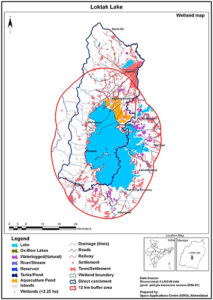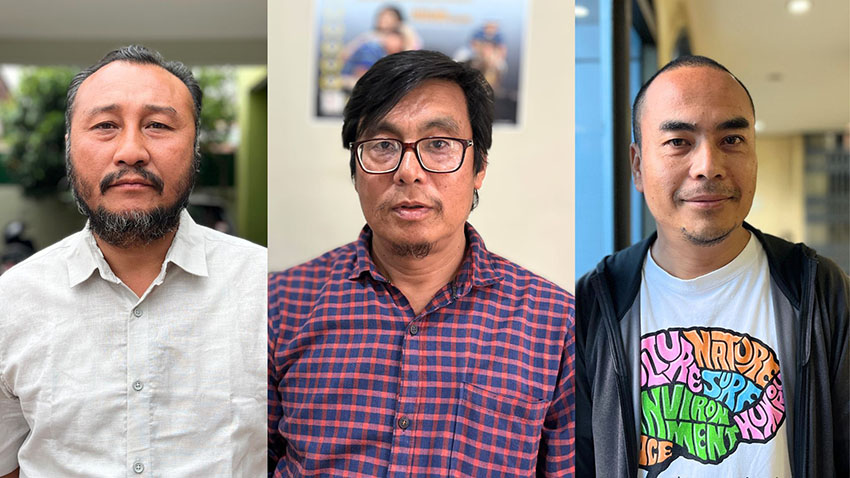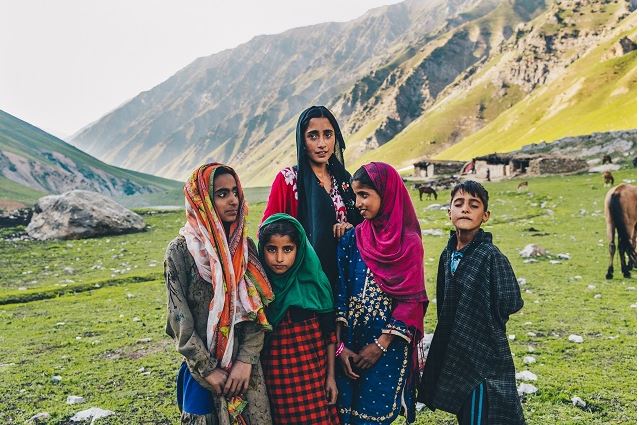Once a thriving and interconnected wetland, Loktak Lake is now a landscape of fragments. Roads slice through its waters, concrete structures rise where there was once the waters of the lake were brimming, and ‘planned’ tourism projects threaten its fragile ecosystem and the people who have been dependent on it. And there is no one stopping this. Neither the Loktak Development Authority (LDA) nor the Manipur State Wetlands Authority (MSWA) fully equipped to ‘defend’ this once vast wetland. Now, amid the plethora of dangers that Loktak faces, a proposed project — the Loktak Lake Experience — may become the breaking point for this lake.
Conceptualised as a part of the Government of India’s ‘Special Assistance to States for Capital Investment — Development of Iconic Tourist Centers to Global Scale’, the Loktak Lake Experience will include a full-fledged luxury resort, a “marine” experience zone and a space for adventure activities.
Through all of this, the state government has forgotten to keep in mind what is actually crucial for Manipur’s development — its people and its environment.
A Shrinking Loktak

Back in May 1988, Loktak Lake was reported to cover an area of 278 Sq.Km, according to WAPCOS’s report ‘Identification Report on Development of Loktak Lake Manipur’. Three years later, Loktak Lake was designated as a Ramsar site providing the framework for the conservation and wise use of this wetland and its resources. At the time the size of Loktak was estimated to be 26,600 ha or 266 sq. km. Then in 1993 Col.N.P.K Nambiar, the first Director of LDA, in his article “Ithai Barrage-A Broad Review”, noted that at its full capacity, the waters of the Loktak Lake would spread over an area of 286 sq.km.This area of Loktak was based on the official submission made by the government of India to the Ramsar Office. This area further reduced to 236.21 sq. km, a number defined by the Loktak Protection Act (LPA) in 2006. Overall, in a span of 16 years, the area over Loktak Lake decreased by nearly 30 sq. km. or 2,979 hectares . This massive reduction was never explained by the government, who turned a blind eye.
While it is not clear how the LPA came up with the 236.21 Sq.Km figure, it divided the lake into a core area of 70.30 sq.km and a buffer zone of 165.91 Sq.Km. In addition to this, the government ‘removed’ 5 Sq.Km for Takmu Fishery and another 40 Sq.Km. for Keibul Lamjao National Park (KLNP). As a result of these changes, the state government’s policy governing the lake (LPA) now only applies to 191.21 Sq.Km. This restricted application of LPA is problematic as the National Park and the Fishery are ecologically connected and any activity around them would have direct implications on Loktak. The state’s Tourism Department is attempting to exploit this weakness in the legislation governing the lake to to initiate projects in Loktak,
What we are witnessing now is that despite the Ramsar Convention, Loktak Protection Act and the Wetlands Rules of 2017, there is an intentional effort by the government of Manipur to carve out parts of Loktak as zones catering to tourism and “development”. This stems from the erroneous belief that laws and rules meant for the protection of wetlands in fact hinder tourism and effectively development. This is made evident in the ongoing hearings around a suo motu petition by the Manipur High Court that addresses the needs to protect the Loktak. In the series of arguments in this PIL, the Loktak Development Authority, Manipur State Wetland Authority and the government’s Tourism Department argue that the Sendra, Thanga, Manungpat and Takmu area are not within the jurisdiction of official Loktak, thus meaning that any projects taken up in these places will not affect the lake’s ecosystem.
In this article I will focus on the ongoing effort to ‘separate’ the southern portion from Loktak as the state wants it for a project ‘Loktak Lake Experience”.
Loktak Lake Experience
The Loktak Lake Experience, a tourism project, is part of the Government of India’s ‘Special Assistance to States for Capital Investment (SASCI) — Development of Iconic Tourist Centers to Global Scale’ as a part of which 40 projects were sanctioned across 23 States. The primary objective of this initiative, which has cost a total of ₹3295.76 crores in this financial year 2024-2025, is to comprehensively develop iconic tourist centres in the country, brand and market them at global scale.
On the Union Tourism Ministry’s website, the GOI has provided little information about how these projects were granted. But it is likely the states sent their proposals of the projects, which were then internally scrutinized before being approved. The Manipur High Court is also scrutinising this project.
The Loktak Lake Experience has three components (i) a Luxury Resort at Moirang (including a cafe, theme restaurant, 12 cottages, a conference block, a recreational block and other Utilities, (ii) a marine Experience Zone at Takmu Island (glamping infrastructure, a Loktak Observation Tower, Zip Line, 2 Gazebos, a static hot air balloon, a cultural performance area, 7 kiosks, a visitor centre and other utilities), and finally (iii) a Land Based Adventure Zone at Thanga Island (a floating cafeteria, Hirn rides and trails, water sports equipment, walking trails, a replica of INS Imphal and other Utilities). The amount sanctioned for the proct is 89.48 crores. Till now, 59.05 crores of this amount has been released for this purpose. No other information is available on the three components.
Operational guidelines issued by the Tourism Ministry Development of Iconic Tourist Centres to Global Scale states that the states have been given a timeline of 2 years for completing the projects. The guidelines further mention that the state government need to submit a Detailed Project Report (DPR) in order to avail this scheme and that at the time the DPR is submitted, the land around which the projects are planned should be contiguous, encumbrance free and owned by the state governments. It is the state government’s responsibility to ensure the procurement of all the relevant clearances and No Objection Certificates, which are a mandatory part of the DPR. While I’ve been denied access under RTI by the Ministry of Tourism on the pretext [Section 8 (iv)] that sharing the DPR will amount to harming the commercial and competitive position of a third party, it is clear that the government has not gotten any of these clearances.
Let us take a look at the project’s components and examine each one of them in order to understand if they require clearances and the multiple implications on the Lake.
First, let us look at the component in Moirang area. It is practically in the Loktak Lake’s zone of influence. Moirang is the immediate lake shore town and due to its booming market and population, the inflow streams from the town to the lake has been a concern because of waste dumping. Zone of Influence is a concept under the National Wetlands Rules 2017 (WR17 henceforth) which where it is defined “as as area, development activities wherein are likely to induce adverse changes in wetland ecosystem structure and (ecological) functioning”. As per the rules, activities are categorized as prohibited, allowed or regulated. Loktak’s zone of influence has not been demarcated nor the list of activities been defined. While the details of the proposed luxury resort is not known, it will surely have major implications on the lake. Even as the Moirang municipality waste remains unmanaged, building new tourist structures inviting tourists will invite more dumping of waste into the Loktak.
The second component is related to the Takmu area. Strangely, while the name of the project is Loktak Lake Experience, this component is called the “Marine Experience Zone”. In other words, the government is attempting to emulate the sea in a wetland. Our lawmakers definitely dwell in strange imaginings. This is not the first time that this idea has taken root around Loktak Lake. In the recent past, the same tourism department wanted to fill up the Sendra lake shoreline with sand and convert it into a sea beach. At the time, in order to obtain approval for the project, which was called the “Loktak Lake Eco-Tourism Project”, the state government had claimed that Sendra is not in the Loktak area and its zone of influence. Such is the desire of our Ministers to build BIG projects without any concern for their land.
Takmu is a part of Loktak although an artificial stretch of road that connects Moirang and Sendra island has severed it from the main Loktak area – one of the first intentional fragmentations of Loktak.
Since the Takmu Fishery is under the jurisdiction of Directorate of Fishery, it is governed by the Manipur Fisheries Act and the Rules of 1988 and 1998 respectively. Article 5 of these Rules is especially relevant to the project. It says, “Land within the boundaries of the government fishery shall not be used for cultivation, homestead or any other purpose except as fishery”. This means that even the idea for setting up a tourist project at Takmu, leave alone clearance, would have been out-rightly rejected.
The third component of this project proposal is the Land Based Adventure Zone at Thanga Island. The Integrated Management Plan of Loktak describes these islands of Ithing-Sendra, Thanga and Karang as located in the center of Loktak. Thanga is now connected by an iron bridge which goes through Ithing Sendra. All these islands are primarily fishing villages. The lives of these residents depend on Loktak. However, according to the Tourism Department, like Sendra, Thanga is not a part of Loktak and neither are they in even in its zone of influence. Any large scale activities such as planned under this component at Thanga island is critical for the health of Loktak. Even if the legal jurisdiction is with the Forest Department the impact of this project on Loktak must be assessed beforehand and that Wetlands Rules and Guidelines must be adhered to.
Misplaced Tourism promotion at Loktak
From the last few eco-tourism initiatives at Loktak it is clear that the government is keen to promote high-end tourism that includes the setting up of floating restaurants, high-speed motorized boating, sea beaches, a golf course, five-star luxury resorts etc. There is no talk of homestays owned by locals to augment the income of fishing families, there is no mention of the timetested canoes where local fishers can take travellers deep inside the lake. What about bird watching where so many migratory birds come ? The government is also not interested in promoting local youths who can operate their own tourism businesses.but instead what it intends to do is take over the lake, hand it over to the big players and ultimately destroy the ecosystem itself. If tourism is planned as one of the key economic activities for the state, then it is critical to have a comprehensive dialogue on the kind of tourism that must be promoted in Manipur, including around Loktak. I’ve looked at the Manipur Tourism policy in detail in a report titled “Corporatizing Tourism in Manipur”,. The policy lacks a consideration of the people and the environment at its core. In a place like Manipur there is great need to center stage the environment and people.
If the Loktak Lake Experience project is allowed to proceed, it will destroy the wetland ecosystem restrict fishing areas, reduce the space for migratory birds, and more critically set a legal precedent that will allow such more destructive projects. The Loktak Lake Experience must be scrapped. A new thinking must evolve on tourism that revolves around wetlands and the communities.











